You can store various foods in underground pits for extended periods when you follow proper storage practices. Root vegetables like potatoes and carrots will last 3-9 months, while grains such as sorghum can stay fresh for up to 18 months in ideal conditions. The key is maintaining temperatures between 32-38°F and relative humidity levels of 75-95%. You'll need to place your pit below the frost line (1-2 meters deep) and use proper insulation materials like straw or hay. Regular inspections every 2 months will help prevent pest problems and guarantee your food stays preserved. Understanding the specific needs of different foods will maximize their storage life.
Optimal Sorghum Storage Timeline
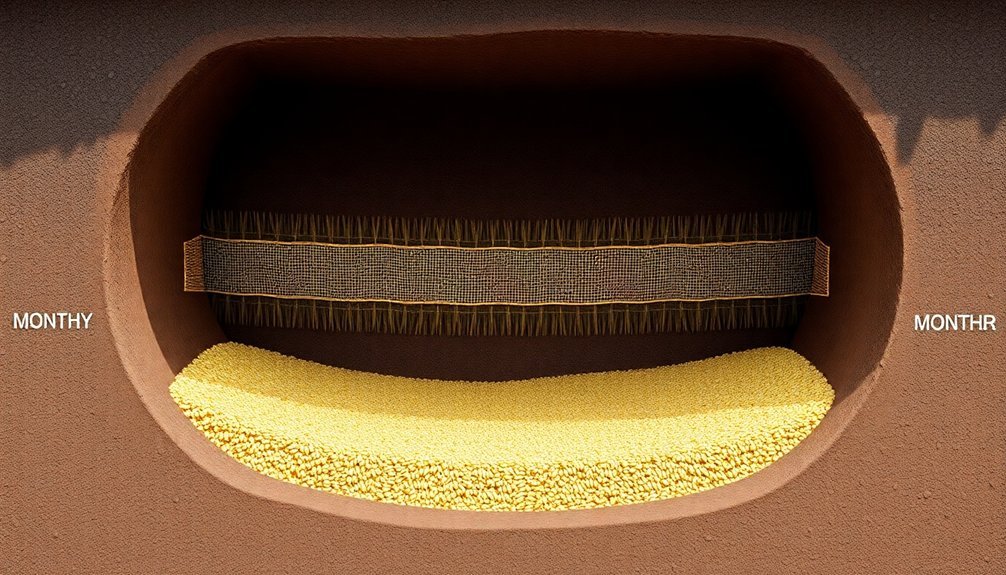
The ideal storage timeline for sorghum in underground pits spans about 18 months when the pit remains undisturbed. However, you'll notice considerable variations in storage duration, ranging from 4 to 36 months, depending on various factors and management practices.
You shouldn't store your sorghum beyond 7-9 months if you want to minimize losses and maintain quality. Studies from Ethiopia's eastern Hararghe region show that even after seven months, you can expect losses between 2% and 13%. Traditional practices have revealed that average grain loss reaches 15% after one year in pits. If you're opening the pit frequently, you'll reduce the storage period considerably.
To maximize your storage success, you'll need to evaluate alternatives to traditional underground pits. Metal silos and above-ground bins lined with plastic offer better protection and longer storage periods.
These modern solutions can help you maintain seed germination rates above 90%, unlike underground storage where germination can plummet from 83% to 27% in just seven months.
Remember that your storage choice directly impacts grain quality. While underground pits have served communities traditionally, they're not ideal for long-term storage due to risks of mold development, insect infestation, and soil contamination.
Environmental Impacts on Storage Duration
When considering underground storage duration, environmental conditions play a crucial role in preserving your food supplies while reducing energy consumption and waste.
You'll find that underground pits naturally maintain stable temperatures thanks to soil insulation, which directly impacts how long your food stays fresh.
The consistent underground environment helps you extend food shelf life while using less energy than conventional storage methods. You won't need excessive heating or cooling systems since the soil maintains ideal temperatures year-round. Less than 55% humidity helps maximize preservation of stored goods.
This natural temperature regulation's particularly beneficial when you're storing temperature-sensitive items, as it prevents spoilage and reduces waste.
Your stored food will generate less methane and CO2 compared to food that ends up in landfills, and you'll contribute to resource conservation by preventing food loss.
The limestone rock structure that's often present in underground storage is three times stronger than concrete, protecting your supplies from external threats and environmental variations.
Common Vegetable Storage Periods
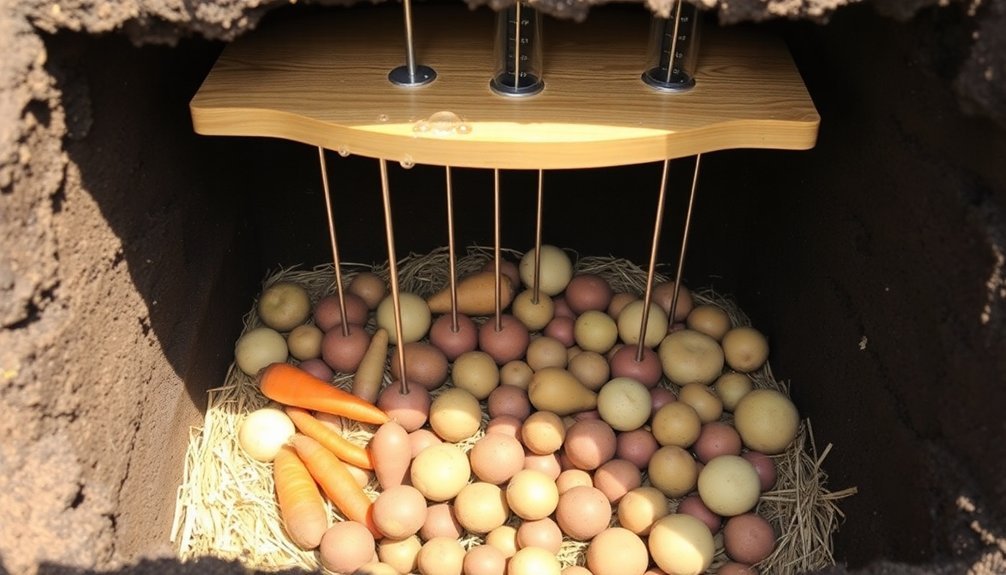
According to storage duration tests, different vegetables maintain their freshness for varying periods in underground pits. You'll find that root vegetables like potatoes, carrots, beets, turnips, and rutabagas are your best options for long-term pit storage, lasting several months when stored at 34°F to 40°F with high humidity. Potatoes need special attention – cure them in a dark, ventilated area at room temperature before placing them in your pit. The pit should include a base layer of sand to help maintain optimal storage conditions.
| Vegetable Type | Storage Duration | Required Conditions |
|---|---|---|
| Root Vegetables | 3-9 months | Cool, high humidity |
| Cruciferous | 1-2 weeks | Cool, separate from ethylene producers |
| Winter Squash | Several months | Initial warm cure, then cool storage |
Your leafy vegetables like lettuce, broccoli, and cauliflower won't last as long in pit storage, typically maintaining freshness for only 1-2 weeks. They're also sensitive to ethylene, so keep them away from fruits. Cabbage is an exception – it'll last several months if you store the entire plant with roots in moist sand. For best results, make certain proper ventilation in your pit and regularly check for any signs of spoilage.
Grain Preservation Time Limits
Throughout extensive field trials, grain storage duration in underground pits has proven highly dependent on environmental controls and initial grain conditions.
You'll find that under ideal conditions, you can store sorghum for up to 3.5 years, but this requires careful management of temperature and moisture levels.
You need to maintain temperatures below 25°C, as higher temperatures will dramatically reduce storage life. For every 10°C increase, you'll lose half of your potential storage time.
Your grain's moisture content is equally important – keeping it between 13-15% is essential, and reducing moisture by just 1% can extend storage life by 50-75%.
You'll experience shorter storage periods if you frequently open your pit or can't control environmental factors. Without proper management, you're looking at significant losses ranging from 15% to 50%.
To maximize preservation time, you'll want to construct your pit with vertical sides in clay or conglomerate soil, guarantee proper drainage, and maintain limited access.
Pit Location and Storage Life
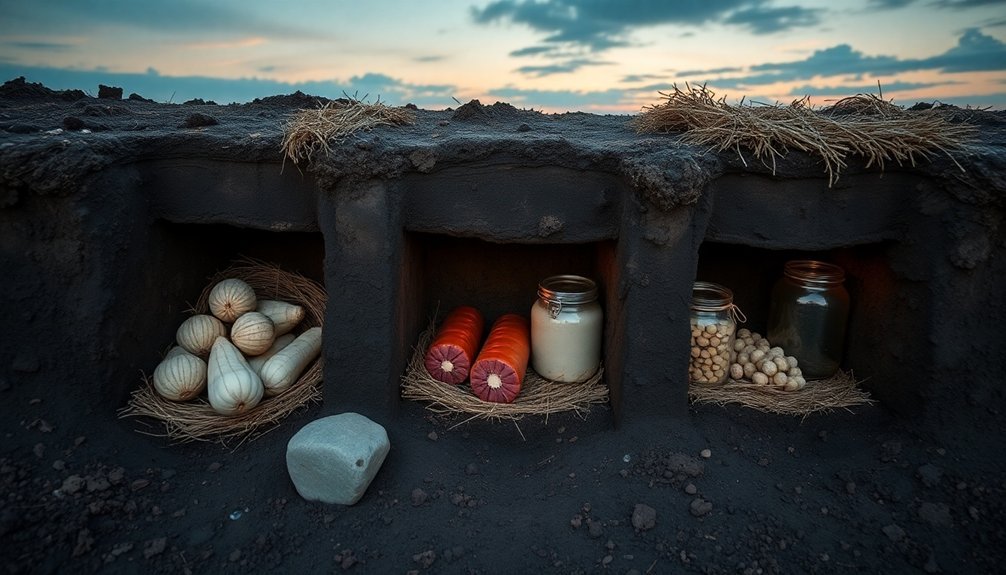
When selecting your underground storage pit location, you'll want to choose a spot with cool, stable ground temperatures and protection from flooding to maximize food preservation.
You can extend your storage life by placing your pit in a well-draining area where the soil temperature stays between 32-38 degrees Fahrenheit and humidity levels remain at 80-90%.
Your pit's placement directly impacts how long foods will last, so it's crucial to monitor these conditions and adjust your storage methods based on seasonal changes and your specific climate.
Optimal Pit Placement Sites
The success of your underground food storage pit largely depends on selecting an ideal location with proper soil conditions and environmental factors.
You'll need to choose a well-drained area that's shaded and easily accessible, while avoiding low-lying spots that could flood or collect water.
Look for stable ground with good soil composition that can maintain the right balance of moisture retention and drainage. The soil should be free from contaminants and pests, and you'll want to stay away from areas with high water tables.
Consider finding a spot under trees or near hills for natural insulation.
You'll need to protect your pit from direct sunlight and secure it against wildlife intrusion. Using weighted-down tarps or covers will help maintain favorable storage conditions.
Keep the area undisturbed by selecting a location away from heavy foot traffic.
For maximum storage life, you'll want to layer your foods with insulating materials like sand or sawdust.
Maintain temperatures between 35°F and 40°F by using leaves and straw as top insulation.
Remember to regularly check for signs of spoilage and confirm your pit remains clean and organized.
Managing Underground Storage Lifespan
Managing your underground pit's storage lifespan requires understanding both internal food properties and external environmental factors. You'll need to monitor water activity, pH levels, and natural microflora in your stored foods, as these directly affect how quickly items spoil. Adding preservatives like salt or sugar can help extend storage times by inhibiting microbial growth.
Temperature control is vital – you'll want to maintain cool, consistent temperatures to maximize preservation. Your pit's relative humidity levels will impact food moisture content, so proper packaging becomes indispensable. Use modified atmosphere packaging (MAP) when possible, and make sure your storage containers protect against moisture, light, and oxygen exposure.
When retrieving food from your pit, follow the "first in, first out" principle to prevent older items from spoiling. You'll need to check regularly for signs of deterioration, such as mold growth or unusual odors.
Don't let temperatures exceed 100°F or drop below 30°F, as extreme conditions can damage your stored goods. When handling stored foods, prevent cross-contamination by keeping items in their original packaging and following safe reheating practices to avoid foodborne illness.
Root Crop Underground Shelf Life
Various root crops maintain impressive shelf lives when stored in underground conditions, with some lasting up to six months or longer.
You'll find that onions are particularly resilient, lasting up to seven months when kept in unheated, well-ventilated spaces.
Potatoes and carrots can stay fresh for six months when properly stored in sand-filled containers that maintain consistent humidity and temperature.
You'll need to pay special attention to certain crops like cassava roots, which have a shorter storage window of about eight weeks.
While yams can technically last up to six months underground, you'll want to use them within three months, as losses increase considerably after this period.
When storing any root vegetables, you'll get the best results by using proper insulation materials like straw or hay.
To enhance storage life, you should pack your crops immediately after harvest and guarantee proper layering in your underground pit.
You'll want to separate layers with straw or leaves, adding adequate insulation between each level.
Remember to top your storage pit with waterproof material to protect against moisture damage and maintain ideal preservation conditions.
Moisture Effects on Food Longevity
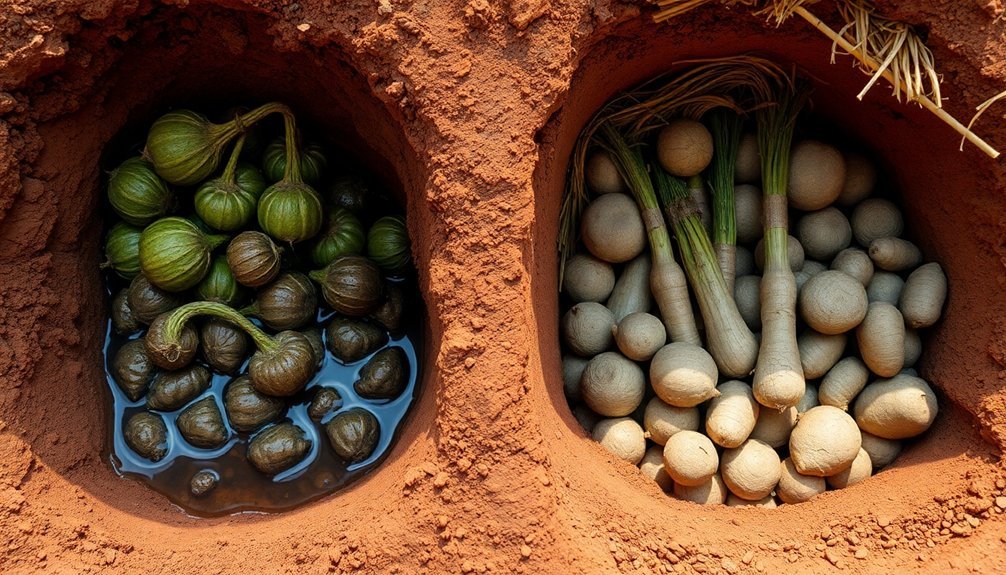
You'll need to carefully monitor and control humidity in your underground pit storage, as moisture levels between 75-95% are vital for preserving root crops while preventing harmful mold growth.
To protect against flooding, it's important to choose elevated ground for your pit and install proper drainage systems using gravel or perforated pipes.
Throughout the year, you should adjust your pit's ventilation based on seasonal changes, opening vents during humid periods and partially closing them during drier weather to maintain ideal storage conditions.
Humidity Control Strategies
Three key humidity factors determine how well your food preserves in an underground pit: ideal moisture levels, effective control methods, and proper integration with other preservation elements.
You'll want to maintain relative humidity between 75% and 95%, with 90-95% being best for most stored foods. To achieve these levels, you can incorporate several proven strategies. A dirt floor serves as your primary humidity regulator, while strategically placed gravel areas allow you to add water when needed to boost moisture levels.
Installing a ventilation system helps you manage both humidity and temperature while removing harmful ethylene gas produced by some fruits and vegetables. You'll find that monitoring devices like RuuviTag can track your pit's conditions, allowing you to make adjustments by opening or closing doors to the outside.
Remember to integrate humidity control with other preservation factors. Keep temperatures between 0-5°C and guarantee complete darkness to prevent bacterial growth.
When you maintain proper humidity alongside these conditions, you'll greatly extend your food's shelf life by preventing dehydration while avoiding excess moisture that could promote spoilage. Regular monitoring and adjustment of these conditions will enhance your storage results.
Flood Prevention Methods
Successful underground food storage requires robust flood prevention measures to protect your preserved goods from water damage. To prevent flooding in your underground storage pit, you'll need to implement several critical safeguards.
Start by extending vent pipes well above ground level to prevent water from entering your storage space during heavy rains or flooding events. You should anchor your storage containers securely to prevent them from shifting or floating if water enters the pit.
Install a reinforced concrete pad at the bottom and use non-corrosive straps to secure containers. Create proper drainage systems around your pit by clearing debris from drains and installing dewatering intakes. You'll also want to protect any electrical components by elevating them above potential flood levels and using waterproof connections.
Keep your stored food safe by using only waterproof containers and avoiding items in cardboard, paper, or cloth packaging. If flooding occurs, you'll need to discard any exposed food items except for undamaged, properly sealed commercial cans and glass jars, which you can salvage by sanitizing them with a bleach solution.
Always maintain detailed records of your stored items and their condition.
Seasonal Moisture Variations
Understanding seasonal moisture variations plays an essential role in preserving food within underground storage pits. You'll need to maintain humidity levels between 85-95% to keep your vegetables fresh and flavorful throughout their storage period.
During fall and winter months, you'll often need to add moisture to your storage pit. You can do this by sprinkling water on the floor, using damp burlap bags, or incorporating moist sawdust or sand around root vegetables. If you're storing carrots, beets, or parsnips, they'll require 90-95% humidity to stay crisp and nutritious.
You'll want to monitor humidity levels carefully using a hygrometer, as seasonal changes can greatly impact storage conditions. When it's too dry, your vegetables will wither and lose flavor, while excessive moisture can lead to mold or rot if temperatures aren't properly controlled.
In very moist areas, you can store vegetables uncovered in bins, but you'll need proper drainage to prevent water from freezing and damaging your cellar. Dug-in root cellars offer natural earth insulation and moisture regulation, making them ideal for long-term food storage.
In particularly dry regions, you'll need to pack your vegetables in damp materials for the best preservation.
Temperature and Storage Duration
The relationship between temperature and storage time plays a crucial role in underground food preservation. You'll find that underground structures naturally maintain stable temperatures around 50°F (10°C) year-round, which can greatly extend your food's shelf life.
When you store items at depths below 4.0 meters, you'll achieve ideal temperatures between 12°C to 16°C, perfect for preserving fruits and vegetables.
If you're planning to store root vegetables, you'll want temperatures between 32°F and 38°F (0°C to 3°C), which can keep them fresh for up to six months. You'll get the best results when you store at deeper levels, as temperatures at depths less than 2.0 meters fluctuate more due to external conditions.
With proper temperature control, you can store grains and cereals for over a year, while fermented foods can last even longer.
Temperature stability directly impacts storage duration, but you'll need to pair it with proper humidity control. You'll want levels below 55% for most items, though root cellars require 80-90% humidity.
Pest Impact on Storage Times
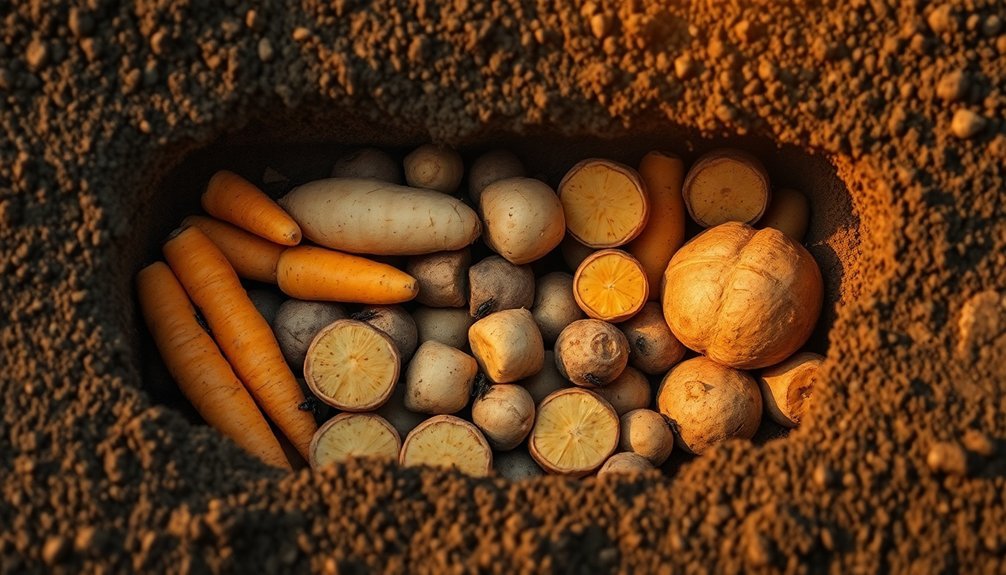
You'll need to carefully seal entry points like cracks, gaps around pipes, and ventilation openings in your underground pit storage, as these are prime access routes for destructive pests.
Rodents can quickly compromise your stored foods through droppings, nesting materials, and direct consumption, so installing metal mesh barriers and maintaining a clean perimeter is essential.
While rodents can damage food stores within days, insect infestations typically take weeks to months to greatly impact your stored goods, though this timeline accelerates in warmer conditions.
Common Pest Entry Points
Securing your underground food storage against pests requires identifying and addressing multiple entry points that can compromise storage times.
You'll need to pay special attention to structural vulnerabilities, as even small holes can allow rodents to infiltrate your storage pit. Make sure you've sealed all exterior penetrations, including ventilation systems and utility lines that connect to your underground space.
When stocking your pit, inspect all incoming items thoroughly before storage, as pests often hitch rides on shipments.
You'll want to implement a FIFO rotation system to prevent items from sitting too long, as products stored beyond 30 days face increased risk of pest infestation. Keep your storage area clean and organized, removing any damaged goods promptly.
Pay close attention to drainage issues in your underground space, as moisture attracts various pests.
Install proper drainage systems and maintain them regularly. If your pit includes older architectural features like crawl spaces or connecting tunnels, you'll need extra vigilance in monitoring these areas.
Consider creating inspection zones along walls and using mobile storage solutions that allow for thorough checks of all areas regularly.
Preventing Rodent Infestations
Protecting stored food from rodents requires a multi-layered defense strategy that directly impacts how long your supplies remain viable.
Start by thoroughly inspecting and sealing all potential entry points around your underground pit storage, including cracks, crevices, and vents, with appropriate weather stripping and mesh screens.
You'll need to use rodent-resistant containers to safeguard your food supplies. Choose ultra-reinforced plastic, glass containers, or airtight metal bins instead of cardboard boxes or plastic bags.
Don't forget to properly store pet food and bird seed in metal containers, as these can attract rodents to your storage area.
Keep your storage area meticulously clean and organized. You should regularly inspect for signs of rodent activity, such as droppings or gnaw marks, and immediately remove any contaminated items.
Maintain proper sanitation by eliminating food debris and clutter that could provide nesting materials.
Consider implementing deterrents like peppermint oil-soaked cotton balls around your storage area.
You'll want to keep stored items elevated off the ground and guarantee all containers that previously held food are thoroughly cleaned to avoid attracting pests.
Regular monitoring and maintenance of these preventive measures will notably extend your food's storage life.
Insect Damage Time Scales
Understanding how quickly insects can damage stored food is vital for effective long-term storage planning. If you're storing food in underground pits, you'll need to account for insect activity that can begin as early as the crop ripening stage and continue throughout the storage period.
Time is important when managing insect infestations in your stored goods. You'll want to implement protective measures quickly, as insects can establish themselves rapidly when conditions are favorable.
In hermetic storage conditions, you can expect:
- Most insect populations to decline considerably within 2 months when oxygen levels drop to 6.4%
- Complete mortality of certain beetles like *Tribolium castaneum* in 30 days when using airtight bags
- Up to 99% mortality of pests like *Callosobruchus maculatus* in less than an hour when combining low pressure with temperature control
To maintain food quality, you'll need to inspect your stored goods every 2 months throughout a 6-month storage period.
Using temperature control methods can be highly effective – exposure to 120°F for just one hour can eliminate many common storage pests. Remember that high moisture content will speed up insect damage, so keeping your storage area dry is vital.
Seasonal Storage Guidelines
The success of underground food storage heavily depends on adapting your practices to seasonal changes. During winter months, you'll need to dig your pits deep enough to stay below the frost line, typically 1-2 meters deep.
Snow cover actually works to your advantage as a natural insulator, but make certain you've marked your pit locations with stakes so you can find them easily.
In warmer seasons, you'll benefit from the natural cooling properties of underground storage, but you'll need to pay extra attention to ventilation.
Install straw chimneys in your pits to allow moisture and gases to escape, particularly in shallower storage areas. You can adjust the depth of your pits based on the climate – shallower in mild winters, deeper in severe cold.
For year-round success, you'll want to monitor and adjust moisture levels seasonally. During dry periods, you might need to add small amounts of water, while in wet seasons, verify your drainage is working effectively.
The key is maintaining consistent temperature and humidity levels, which you can achieve by adjusting your covering materials – using more straw and soil during extreme temperatures and less during moderate weather.
Frequently Asked Questions
How Deep Should Underground Storage Pits Be Dug for Optimal Food Preservation?
You'll need to dig your storage pit 1-2 meters deep, ensuring it's below the frost line. For better temperature control, you can go deeper to 4 meters in warmer regions for ideal preservation.
Can Different Types of Food Be Stored Together in Underground Pits?
You shouldn't mix different food types in storage pits. Keep roots with roots, grains with grains, and vegetables separate. Each food category needs specific conditions to prevent cross-contamination and maintain ideal preservation.
What Materials Are Best for Lining Underground Storage Pits?
You'll get the best results using polyethylene or PVC geomembranes for waterproofing, combined with non-woven geotextiles for protection. For natural options, try clay mud reinforced with fiber and sealed with dung.
How Often Should Underground Storage Pits Be Cleaned and Maintained?
You'll need to clean your storage pit after each use and perform maintenance seasonally. Schedule regular inspections monthly, checking for damage and pests. Don't forget to keep detailed records of all cleaning activities.
Can Underground Pits Be Reused Immediately After Emptying Stored Food?
No, you can't reuse pits immediately. You'll need to inspect, clean, sanitize, and repair any damage first. Check for pests, remove debris, guarantee proper drying, and reapply protective materials before storing new food.
In Summary
You'll find underground pit storage times vary greatly depending on your location, climate, and storage methods. By controlling moisture, temperature, and pest access, you can preserve grains for up to 2 years and root vegetables for 3-6 months. Remember to check your stored foods regularly and adapt your pit's depth and lining based on seasonal changes. The key to long-lasting storage lies in proper preparation and maintenance.

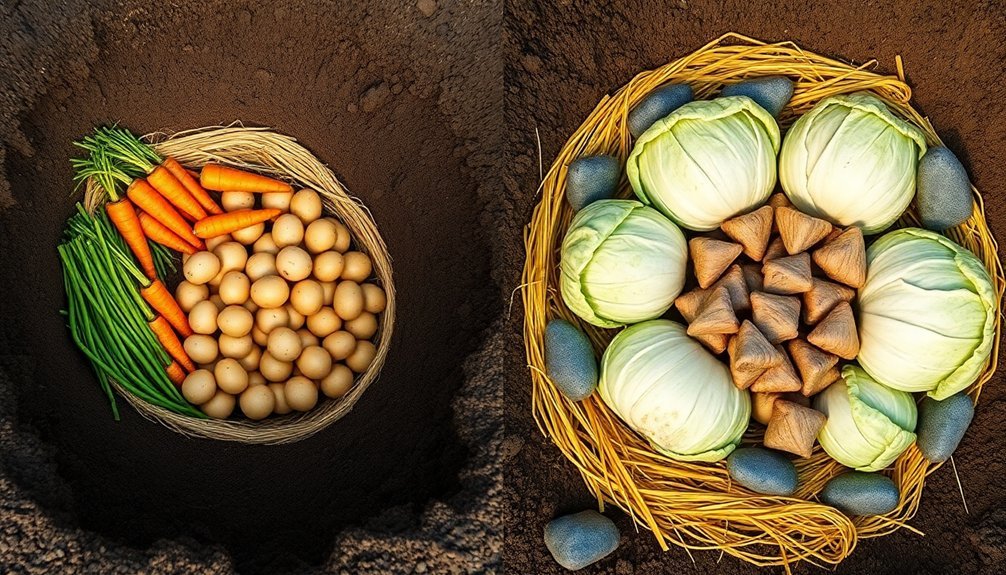
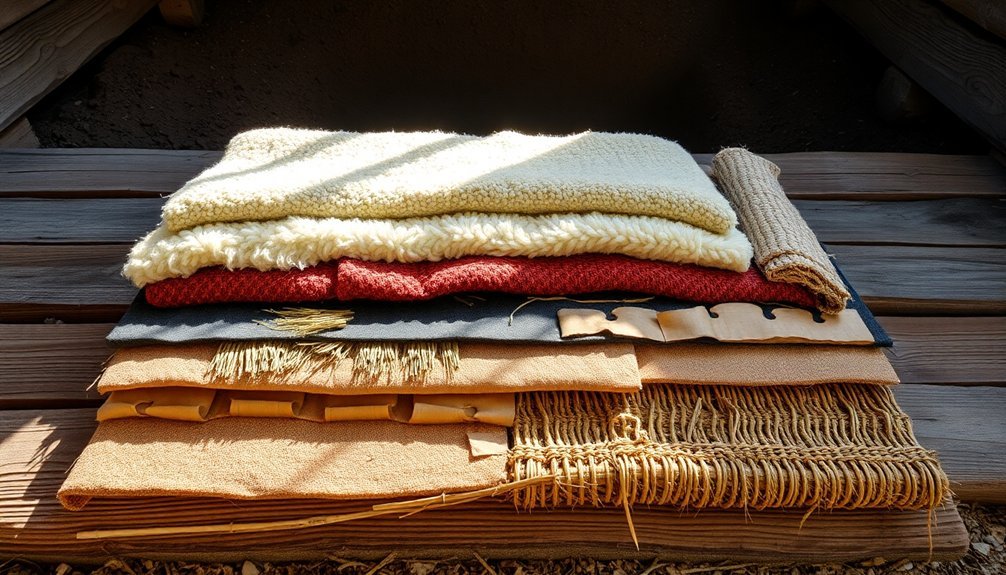
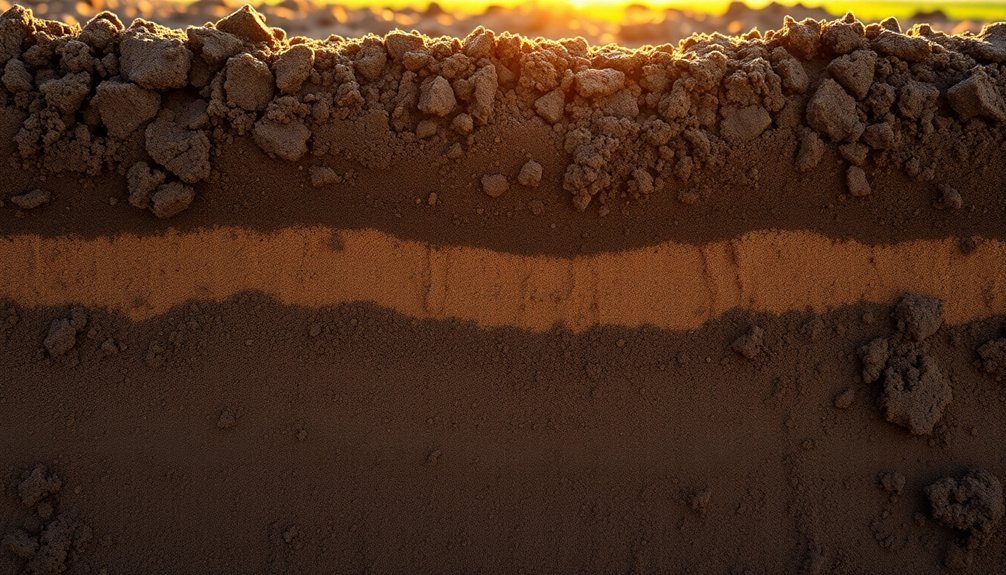
Leave a Reply